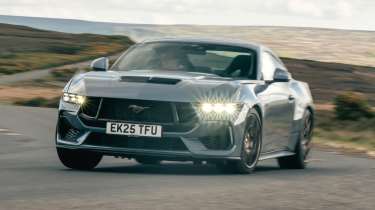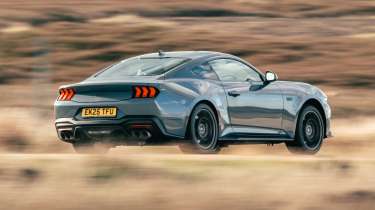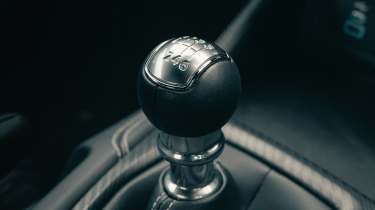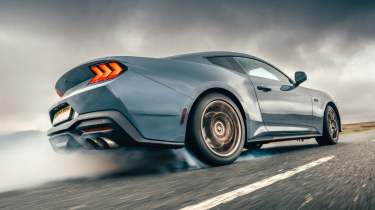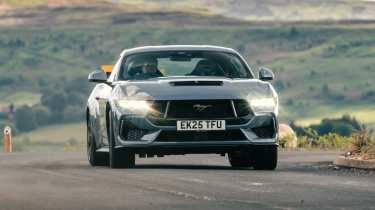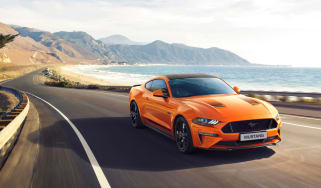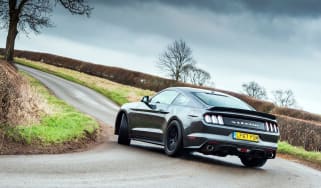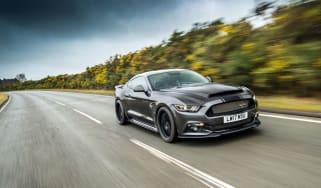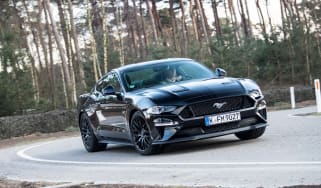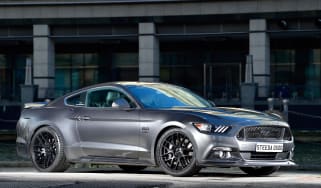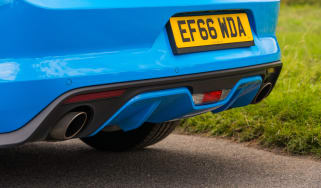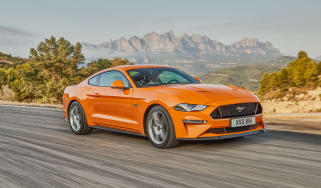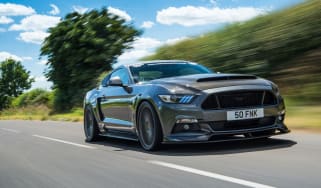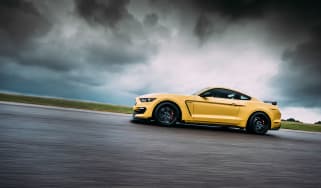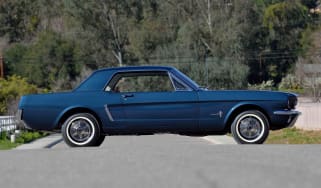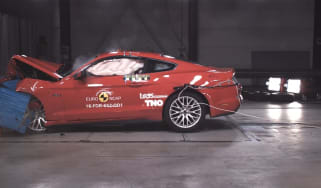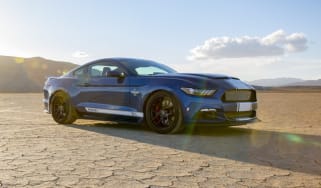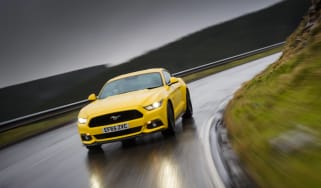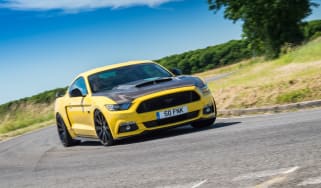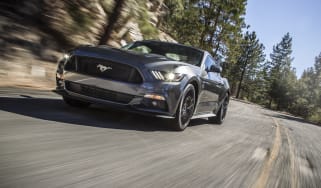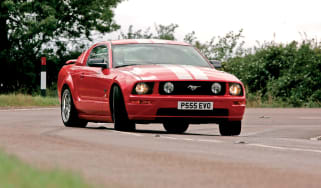Ford Mustang GT 2025 review – BMW M2 rival is the last manual V8
The Ford Mustang is excellent in Dark Horse form, but the standard GT lacks some of the edge of its European rivals
Given it’s one of the final naturally aspirated V8 models on sale in the UK, the Ford Mustang GT really is an easy car to fall for. There’s a strong sense with this car that Ford is pulling out all the stops to continue selling it in the UK, with average fleet emissions regulations meaning it must limit the supply of Mustangs in Europe to avoid fines. That demand is only likely to grow with this current model, because there really isn’t an alternative if you want a manual, rear-drive, naturally aspirated V8 coupe in 2025. In fact, the GT’s most obvious competitor comes from Ford’s own stable – the Dark Horse.
As some performance car lineups are beginning to lose their identity through downsizing, radical new design choices or a combination of both, the Mustang has stayed well clear (for now). Despite being the entry point to the range for UK buyers, it has all of the presence and theatre of its predecessors, proper muscle car looks, a characterful cabin and even that all-important ‘5.0’ badge on the front wings. We drive it on Britain’s roads in manual and automatic-form to find out if that translates to the driving experience.
More reviews
In-depth reviews
Reviews
- Hennessey Super Venom Ford Mustang review – can a Mustang handle 850bhp?
- Ford Mustang GTD 2025 review – nothing like a GT3 RS, but equally mesmerising
- Ford Mustang Dark Horse 2025 review – the last of a dying breed
- Ford Mustang Mach-E GT 2023 review – it’s fast, but is it fun?
- Ford Mustang Shelby GT500 UK review – how does Ford’s maddest muscle car handle Blighty?
- Ford Mustang Mach 1 (2021 - 2023) review – America’s BMW M4 gets track fit
> Ford Mustang GTD 2025 review – nothing like a GT3 RS, but equally mesmerising
Background and model range
The new S650 Ford Mustang is here, and it represents something important – a chance to step away from the horsepower races to experience an analogue, naturally aspirated V8 coupe at a time when legislation is forcing them out of existence.
With the track-prepped Dark Horse and the unhinged GTD road racer, Ford clearly wants us to take the S650-generation Mustang seriously, but it's equally keen to stress that the GT version is absolutely, positively not a track car. It doesn't have the Dark Horse’s beefed up transmission, more focused damper tuning nor its improved cooling package and uprated 447bhp V8, but it’s better suited for road driving, and is more affordable too.
Engine, gearbox and technical highlights
- Last stand for a V8 engine and manual gearbox
- European versions slightly strangled compared to the US
- 10-speed auto optional, if you must
Few European customers chose the four-cylinder EcoBoost engine in the old Mustang, so this time it’s a V8 or nothing. We like that. The 5-litre Coyote unit has been revised for the new GT, with dual-intake throttle bodies, a new induction system and new cams. The result? 440bhp, compared to the old car’s 444 (although torque is up by 8lb ft to 398). You can blame tightening European emissions regulations for the power decrease, and the fact that US-spec GTs get an extra 46bhp. But if that’s what it costs to sell a naturally aspirated V8 coupe in Europe in 2025, then so be it. Just don’t expect much more than a low 20s average mpg figure if you like to use that performance.
The engine is linked up to a six-speed manual gearbox as standard (the Dark Horse gets a more robust Tremec six-speeder), but you can opt for a 10-speed automatic for an extra £2000. Don’t, though. It was this gearbox that really hobbled the Mustang Dark Horse on evo Car of the Year 2024, seemingly absorbing all the engine’s enthusiasm at lower revs and requiring more paddle-flipping than a game of pinball. Exceedingly short ratios often mean you inadvertently hit the redline in manual mode, which in this car, results in the powertrain briefly falling flat on its face. Automatic mode doesn’t help much either, as it frequently shortshifts no matter the mode to ensure you never quite stretch the engine to its full potential – it almost feels like a CVT in the way it slurs around and hunts for gears. The manual, on the other hand, clunks into gear with a heavy, positive action and suits the character of the Mustang better, even though it means the car is four-tenths slower to reach 62mph with a time of 5.3sec.
Performance, ride and handling
- Not as unhinged as you might expect
- Linear power delivery gives it a friendly feel
- Fun on back roads, but a better grand tourer
The GT is big in the brochure (4.8 metres long, 1.9 metres wide, and 1836kg), and can sometimes feel that way on the road too. Yet the burly V8, comfortable seats, decent visibility and progressive control weights make it particularly easy to settle into and take the edge off its size. You get used to it quickly in other words, and when you finally have more room to play with, it starts to click. You can wring more performance out of the car, finding a flow and stretching the V8 right through the rev range.
It really is a lovely engine, smooth yet with real bite to the soundtrack that makes you wonder whether Ford has taken any notice of European noise regulations at all – cold starts are especially old school and a great way to make enemies with your neighbours. With the valved exhaust opened up it snorts and rumbles at low revs, and while it doesn't surge forward with the intensity of a turbocharged V8, the torque build-up is linear and very manageable – clunks and whirs from the powertrain also give it some extra character in a similar manner to an R35 GT-R. In the manual, second gear takes you up to 80mph so you often end up short-shifting and using the mid-range rather than battering the red line. There's not a ripping top end to be enjoyed, though, so you don't feel like you're missing out on much.
There are modes galore in the new Mustang, from Normal through Sport and up to Track, with Slippery and Drag modes added in for good measure – usefully, these are all accessible via the steering wheel. You can mix and match settings for the steering, throttle map and damping (if you've specified the £1750 MagneRide dampers), but Sport feels cohesive out of the box. There's a bit more steering weight to work against, the engine has sharper pick-up and the dampers hold tighter control of all that weight, giving you more confidence to lean against the grip from the Pirelli P Zeros. ESC off is unusually easy to find too, and there are a multitude of fun modes like line-lock and even a drift handbrake (that doubles as the parking brake when the mode is not engaged).
On warm, dry tarmac the front end finds good bite unless you overcommit with your entry speed, but you find the limits through trust rather than feel; the steering is mute and there isn’t much information coming through the chassis, but the Mustang’s fundamental balance is as friendly as ever, so there are no surprises unless you really push your luck.
Even out of first-gear hairpins the 275-section rear tyres (with a pleasantly chunky 40 profile sidewall to match the fronts) can take almost every ounce of torque from the V8, so you use the throttle to subtly adjust the balance through a corner rather than having complete command over it. In the damp you can get the limited-slip diff working harder, but just as you feel the Mustang coming alive, the balance transitions back to neutral quite quickly. There are more sensory rewards than in a BMW M2, but there isn’t the BMW’s sharpness or expressive balance to be enjoyed beyond that.
Not an out-and-out thriller then, but that doesn't mean that the GT isn't a satisfying car to drive. In fact, it's hard to think of many sub-£60k cars that dust every journey with such a sense of occasion. The Mustang’s engine is a big part of this of course, but there's depth here – the gearbox is a delight to use, the steering response is crisper than on the old GT and the brake pedal is firm with great bite (though like the old car it’s initially quite sharp, making smooth heel-and-toe shifts a little tricky).
All of this makes the GT a treat when you aren't going quickly, so too the ride on the MagneRide dampers. Despite the ‘GT’ name, they’re very firm even in their softest setting but the ride isn't brittle or crashy, and at a cruise they help the Mustang feel settled and keyed in. It’s a quiet car inside too, with an active noise cancelling system that dials out unwanted noise without diluting the wonderful V8 backing track – in fact, it’s amplified by the lack of other sounds. These are the makings of an excellent long-distance GT, which is fitting I suppose.
Driver’s note
‘The manual gearbox is far better suited to the Mustang than the lazy automatic, though you still need to work for your dinner – unless you’re at high revs, the V8 doesn’t have the instant wallop of modern turbocharged rivals. The linear delivery and the Mustang’s natural balance mean it always feels on your side, though.’ – Antony Ingram, contributing writer, who drove the Mustang GT on the sports car group test in evo 336
Interior and tech
- Twin screen dash loses some of the old car’s character
- ‘Drift brake’ a little odd to use
- Quality better than the previous model
Ford is making plenty of noise about the new Mustang’s step forward in interior tech, but something has been lost in moving to the same ‘two massive screens’ solution as employed by every other manufacturer these days. The classic-style eyebrow arches on the dash in the old car have gone, in their place a generic design with the displays tacked on, and there really isn’t much to suggest that you’re in a Mustang.
The central touchscreen is where you configure your drive-mode profiles, which include a variety of options for the instrument layout ahead of you. Track mode serves up a horizontal rev bar across the display, but the ’80s-style ‘Fox Body’ dials are the simplest and clearest to read. You cycle through the drive modes using handy buttons on the new, thicker-rimmed steering wheel, and mercifully there’s a shortcut on the wheel to turn off the lane keep assist, which you need to do at the start of every drive. Not even the analogue, old-school Mustang can escape that. Another quirk is that while that digital dash has some very slick graphics for each of the drive modes, those graphics take slightly too long to clear the display each time, blocking vital information in some scenarios.
Another concession to modernity is the fitment of an electronic handbrake in place of the old manual item, with an optional ‘drift brake’ lever designed specifically for making handbrake turns. You need a track to use it in anger (we’ve not yet had the chance), but it certainly beats a fiddly plastic switch. Otherwise, the driving position is low and cocooned, the standard seats are comfortable (if much less supportive than the optional Recaros) and while the interior does feel built down to a price, it doesn't feel as cheap as it used to.
It might not be an ultra premium cabin but it undoubtedly brings that muscle car feel right through to where you’ll spend most of your time, with a similar feel to other through-and-through muscle cars the swansong 6.2-litre Chevrolet Camaro. Wind noise and exhaust drone are something you’ll have to compete with on occasion, and some sharp plastic trim surrounding the door handle even drew blood in my case, but these are things you’ll likely be willing to turn a blind eye to if this is the package you’re looking for. After all, there’s no alternative currently on sale.
Price and rivals
With no four-cylinder model to tempt buyers into the showroom with a low starting price these days, you’re looking at £58,470 on the road for a Mustang GT. That’s around £12,000 less than the Dark Horse, though will sound impossibly expensive to anyone reading this in the US, where a Mustang GT starts at around £35,000 (and the still-on-sale Ecoboost at a supermini-like £23k…).
More pertinently, a price tag in the £50k range drops the Mustang right into a market occupied by the £55k Alpine A110, £54k Porsche 718 Cayman, and £59,000 BMW Z4 M40 (and £50k BMW M240i xDrive). It’s an eclectic bunch, expanded further if you roll in spiritual rivals like the BMW M2 and Lotus Emira as we did in a recent group test, though at a strict sub-£60k budget you’ll struggle to find as much character as the V8-powered Ford can offer.
Ford Mustang specs
| Mustang GT | Mustang Dark Horse | |
|---|---|---|
| Engine | V8, 5035cc | V8, 5035cc |
| Power | 440bhp @ 7250rpm | 448bhp @ 7250rpm |
| Torque | 398lb ft @ 5100rpm | 398lb ft @ 5100rpm |
| Weight | 1804kg | 1812kg |
| 0-62mph | 5.3sec (4.9sec auto) | 5.2sec (4.4sec auto) |
| Top speed | 155mph | 163mph |
| Basic price | £58,470 | £70,740 |
